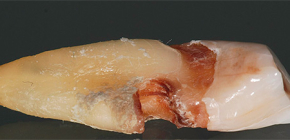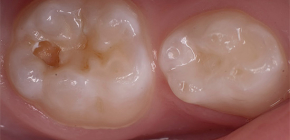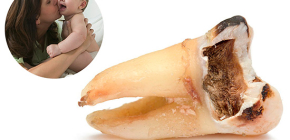Caries

Chronic caries is so insidious that often the patient cannot pay attention to tooth decay in time. The specific features of this pathology in the form of a sluggish and prolonged course contribute to the fact that problems are often attributed to “bad ecology”, “terrible heredity”, etc. In fact, chronic caries is a consequence of the same mistakes in nutrition and dental care due to which other forms of carious lesions develop. So, let's understand in detail what exactly is the specificity of chronic caries and how to deal with it correctly ...

Caries is not only dark spots on healthy white teeth. In many cases, this disease develops in such a way that the owner of the teeth, and sometimes even the dentist, does not notice it. It happens that caries makes itself felt only by pain in the affected pulp, and at this stage it is already necessary to remove the nerve from the tooth and put a large filling. In these cases, they talk about hidden caries - a form of the disease in which it is not visible during a visual examination. We will talk more about hidden caries and its features later on ...

The most noticeable form of caries with the most unfavorable prognosis is the decompensated form. It is with her that a situation develops when several teeth are destroyed at the same time, sometimes - even everything, the patient is constantly tormented by toothaches, and to treat each tooth you have to remove nerves or even place crowns. Let's see why this form of caries develops and how to deal with this disease.

According to statistics, almost nine out of ten inhabitants of the planet face caries in their lives, and for many this disease causes tooth loss at a fairly young age. Of course, many would like to buy an effective tool for caries, but ... they do not find such products on sale. Are there any cures for caries, and if so, what are they? Let's get it together.

Diagnosis of caries is the main procedure during regular check-ups at the dentist. Basically, the dentist carefully examines them with a mirror and examines them with a probe to search for caries-affected teeth. In most cases, this is enough to identify affected areas. But there are situations in which caries is diagnosed only with the help of more complex and technologically advanced methods. We will talk about all methods of detecting caries further, after which you will well understand why the doctor uses this or that device in the clinic.

Before making itself felt in full measure, caries in its development goes through the initial stage associated with the gradual demineralization of tooth enamel. This process has its own interesting features, and the corresponding initial caries is characterized by a special clinical picture and diagnostic methods. We will talk about what causes the carious process, how it is treated at the initial stage, and how we can protect ourselves from it.

It is known that tooth decay is distinguished by its insidiousness among other known types of caries. Since tooth decay occurs under the gum, it is not always possible to immediately determine the problem. However, complications in such cases can lead to really serious consequences ...

There are several stages in the development of the carious process: first, the enamel of the tooth is affected, then dentin is involved in the destruction process, and after it the pulp. And if at the initial stages pathological changes are still reversible (stain stage) and can be cured by remineralizing procedures, then the treatment of dentin caries without using a drill is usually no longer possible. About the features of caries at this stage, about how it is diagnosed and treated, we will continue and talk ...

There is a fairly widespread popular belief that caries can be transmitted from person to person through a kiss and that they can be infected, like any other infection, in contact with the carrier. To some, on the contrary, this version of caries will seem ridiculous and even absurd. Well, let's see if caries can really be infected through a kiss or is it still a myth that has no scientific basis ...
